The apparently anthropomorphic appearance and meaning of (at least some of) the T-shaped pillars known from Göbekli Tepe, Nevalı Çori (and likely many of the other sites with similar pillars in the area too) could have been convincingly explained by a number of very characteristic details depicted in reliefs on these pillars. Among them arms and hands as well as stola-like garments and, in the case of Göbekli Tepe’s Pillars 18 and 31 (in Building D), even belts and loincloths.
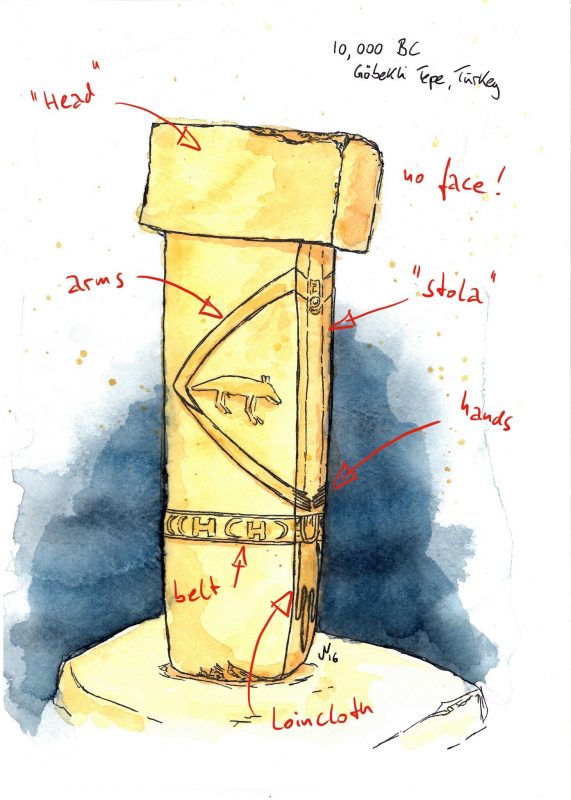
The characteristic T-pillars can be recognized as larger-than-life human(-like) sculptures due to a number of specific elements. (Illustration: J. Notroff)
It was the discovery of these peculiar new type of T-shaped pillars, for the first time excavated in the Pre-Pottery Neolithic settlement of Nevalı Çori on the middle Euphrates (like Göbekli Tepe in Şanlıurfa Province) in the 1980s [external link], which also shed new light onto another find – until then rather considered an archaeological oddity – of a unique piece of sculpture: The so-called Kilisik Sculpture found in 1965 near Adıyaman in southeastern Turkey.
- Cast of the ‘Kilisik sculpture’ from Adıyaman. (Images: Archäologisches Museum der WWU Münster, CC BY-NC-SA 4.0)
- Cast of the ‘Kilisik sculpture’ from Adıyaman. (Images: Archäologisches Museum der WWU Münster, CC BY-NC-SA 4.0)
- Cast of the ‘Kilisik sculpture’ from Adıyaman. (Images: Archäologisches Museum der WWU Münster, CC BY-NC-SA 4.0)
- Cast of the ‘Kilisik sculpture’ from Adıyaman. (Images: Archäologisches Museum der WWU Münster, CC BY-NC-SA 4.0)
The sculpture was originally found by a local farmer and purchased from him by two archaeology students working at the excavations in Arsameia “about an hour by horse north-west of the Roman bridge in the village of Kilisik” and later transferred to the Archaeological Museum in Adıyaman (Hauptmann 2012, 18-20). The stele is measuring c. 80 cm in height and carved from limestone, the conspiciously T-shaped head shows a broader back and rather slim face with an emphasized nose and only suggested eyes. Arms are depicted on both sides of the body, the hands meeting above the belly at some bulge which can be identified as head of another, smaller figure below. Whose left arm is more or less hanging down, but the right hand seems to reach towards its lower body – where a circular hollow was carved into the stone (Hauptmann 2012, 20 (in an earlier interpretation, Hauptmann (2000, 8-9) even discussed the possibility to read head and body of the smaller figure as navel and penis depictions, cf. also Verhoeven 2001)). Whether or not this hollow already was part of the sculpture’s original design or was later added (maybe for a phallus to be mounted or something similar, or to indicate a hermaphroditic nature of the figure as e.g. Hodder and Meskell (2011, 238) suggested) remains unclear.
Although its original find context still could not have been figured out (Hauptmann (2012, 18) suggested an early Neolithic settlement north of the village), the Kilisik Sculpture is an extraordinary find among depictions and sculptures of that period due to its specific shape, apparently combining characteristics of very different elements of other types of known Neolithic sculpture:
- While significantly smaller, it still shares the rather abstract T-form of the much larger (in case of Göbekli Tepe up to 5.5 m high) T-pillars – including the depiction of arms on the sides and hands above the ‘stomach’.
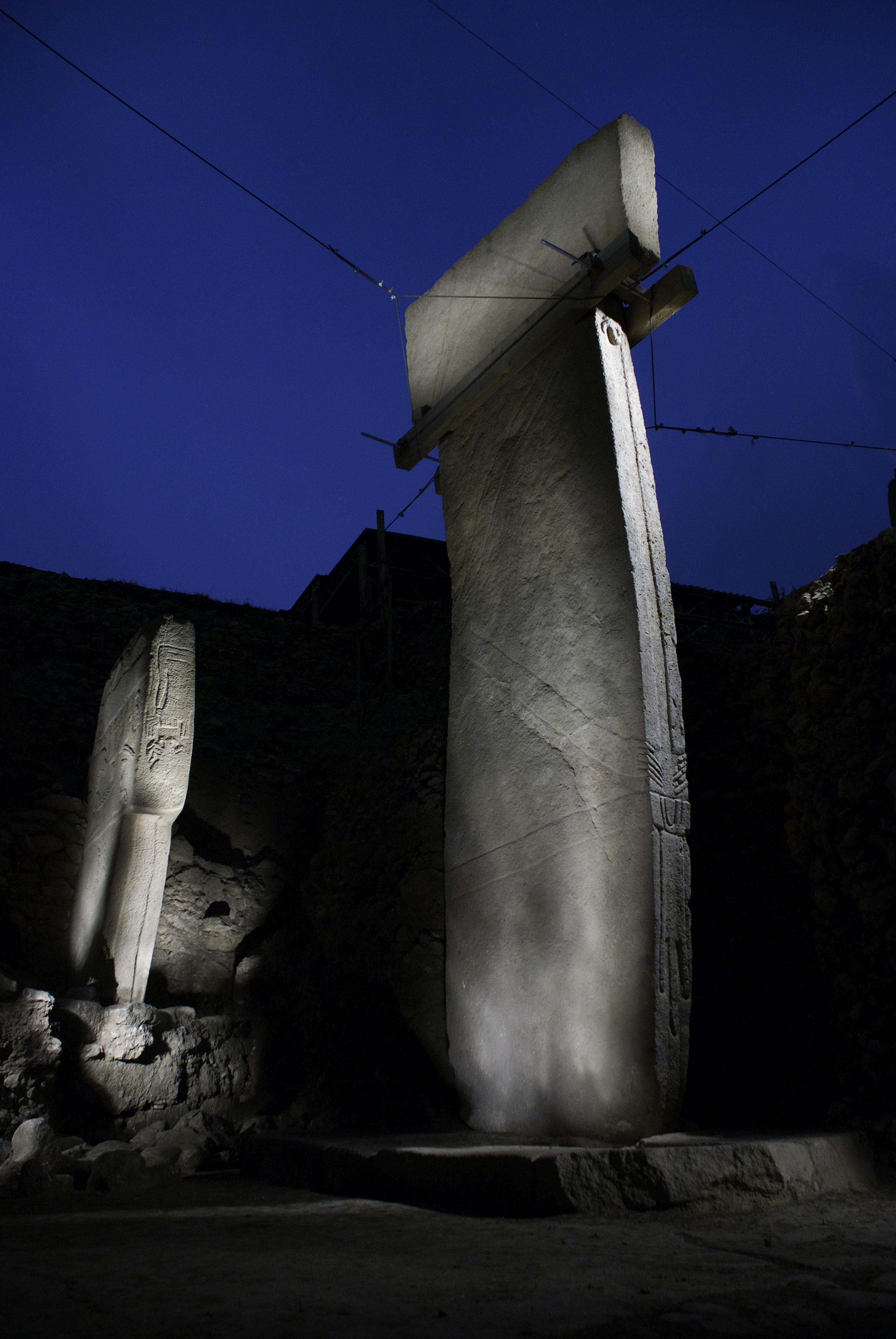
Pillar 31 in Building D showing anthropomorphic features like hands and arms and pieces of clothing (Photo: N. Becker, DAI).
- The sculpture’s face, however, in particular the emphasised nose, resembles a group of more naturalistic, often (but not exclusively) life-sized human sculptures, of which the one from Urfa-Yeni Mahalle (so-called Urfa Man) may be the best known example (showing a similar gesture, also reaching towards the lower body, both hands covering (and hiding) the genitals – or pointing towards a small hollow (into which, again, a phallus could have been inserted?)). From Göbekli Tepe there are known at least a number of limestone heads (originally most probably belonging to similar sculptures) – also featuring the characteristic nose part of the face.
- So-called Urfa Man is considered the oldest known life-sized sculpture of a man (Photo: J. Notroff, DAI).
- Limestone head from Göbekli Tepe, supposedly part of a sculpture similar to ‘Urfa Man’ (Photo: N. Becker, DAI).
- Finally, the Kilisik Sculpture combining a larger figure grabbing a smaller one by its head below again is reminiscent of another peculiar find of a large composite sculpture from Göbekli Tepe – featuring a larger animal (?) with human-like arms grabbing for another individual’s head, and yet another, smaller, figure underneath. A similar, also composite sculpture was furthermore discovered almost 20 years earlier at Nevalı Çori too (Schmidt 2012, 73-76).

Composite sculpture from Göbekli Tepe (Photo: N. Becker, DAI).
This combination of very specific and very different elements and ideas makes the sculpture from Kilisik so special among Pre-Pottery Neolithic image representations and forms an interesting link between the various types of sculptural art of the period. Hauptmann (2012, 22) even suggested to interpret this scene as a ‘mother and child’ motive (known i.a. from two of Nevalı Çori’s clay figurines). In this case the Kilisik example would represent the first female depiction to be associated with the T-shaped sculptures. Since the depiction lacks clear sexual characteristics, this remains a rather vague and ambivalent possibility asking for further research. The Kilisik Sculpture, however, already could demonstrate that with a growing number of such finds our understanding of the complexity of early Neolithic art is still increasing.
Refrences:
H. Hauptmann, Ein frühneolithisches Kultbild aus Kommagene, in: J. Wagner (ed.), Gottkönige am Euphrat. Neue Ausgrabungen und Forschungen in Kommagene, Mainz 2000, 5-9.
H. Hauptmann, Frühneolithische Kultbilder in der Kommagene, in J. Wagner (ed.), Gottkönige am Euphrat. Neue Ausgrabungen und Forschungen in Kommagene, 2. erweiterte Auflage , Darmstadt/Mainz 2012, 13-22. [external link]
I. Hodder and L. Meskell, A “Curious and Sometimes a Trifle Macabre Artistry. Some Aspects of Symbolism in Neolithic Turkey, Current Anthropology 52(2), 2011, 235-263. [external link]
K. Schmidt, A Stone Age Sanctuary in South- Eastern Anatolia, Berlin 2012.
M. Verhoeven, Person or Penis? Interpreting a ‘New’ PPNB Anthropomorphic Statue from the Taurus Foothills, Neo-Lithics 1/01, 2001, 8-9. [external link]
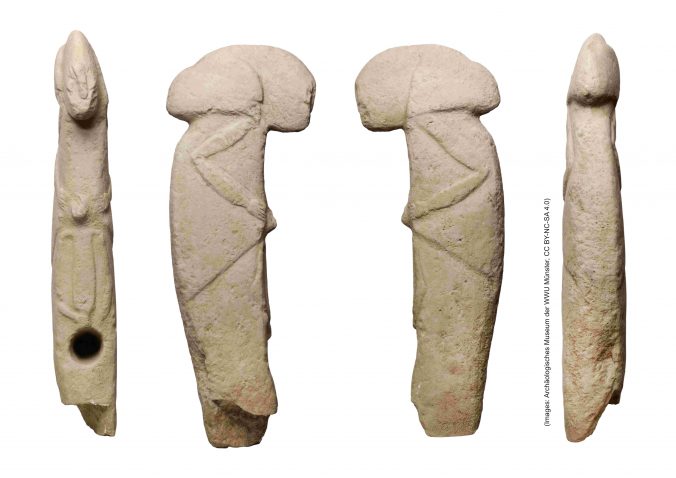
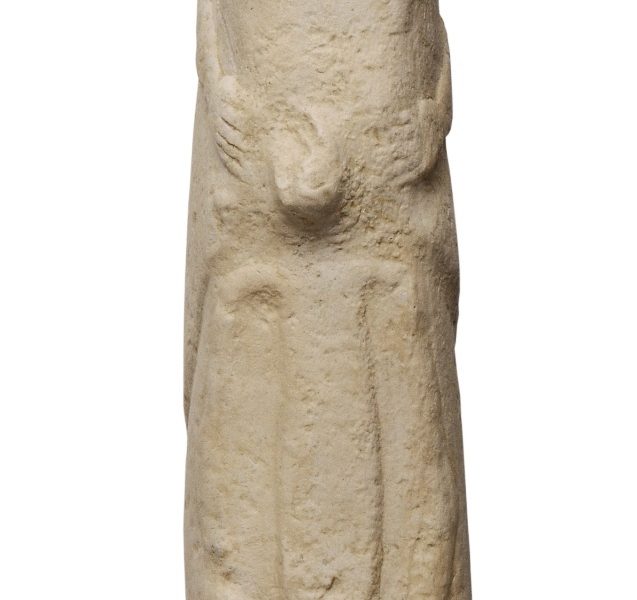
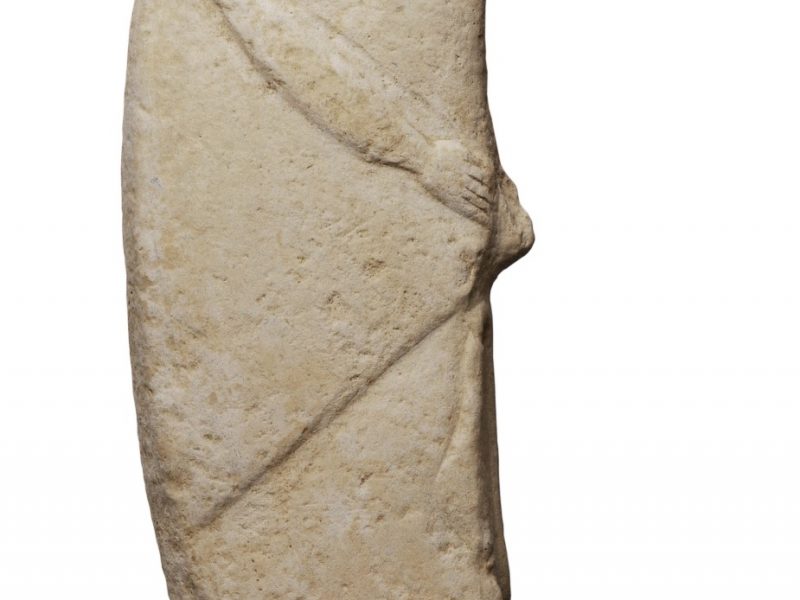
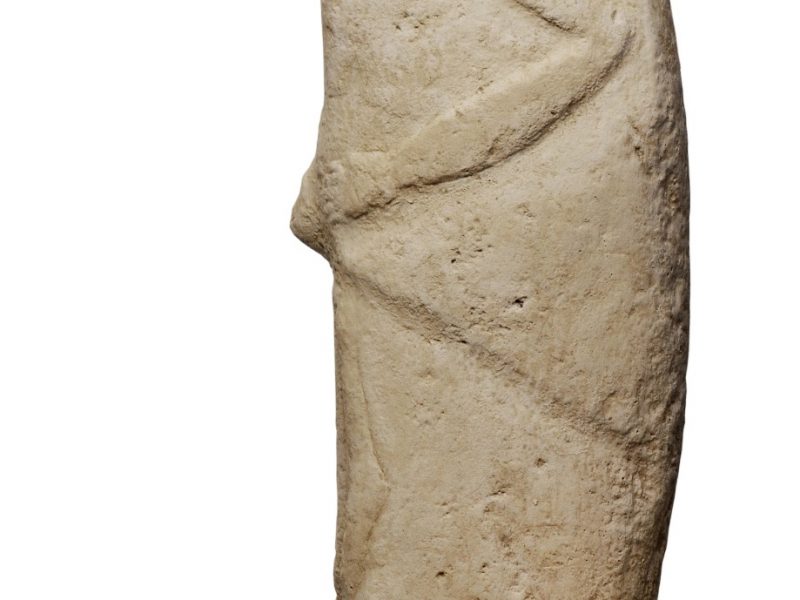
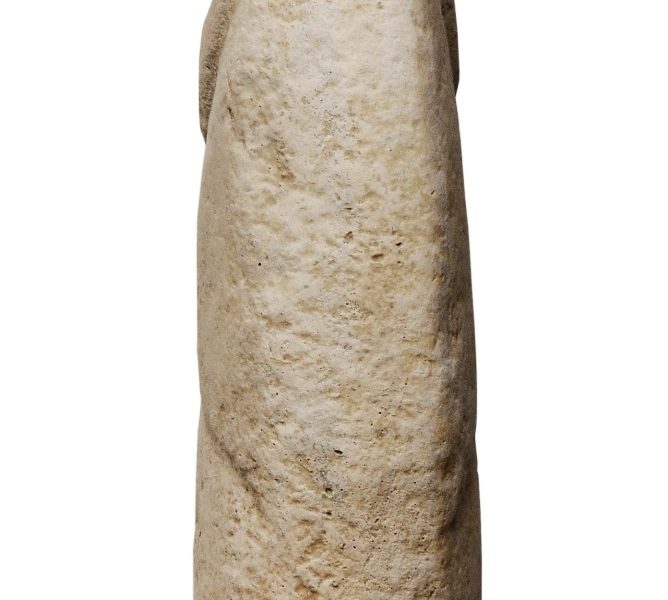
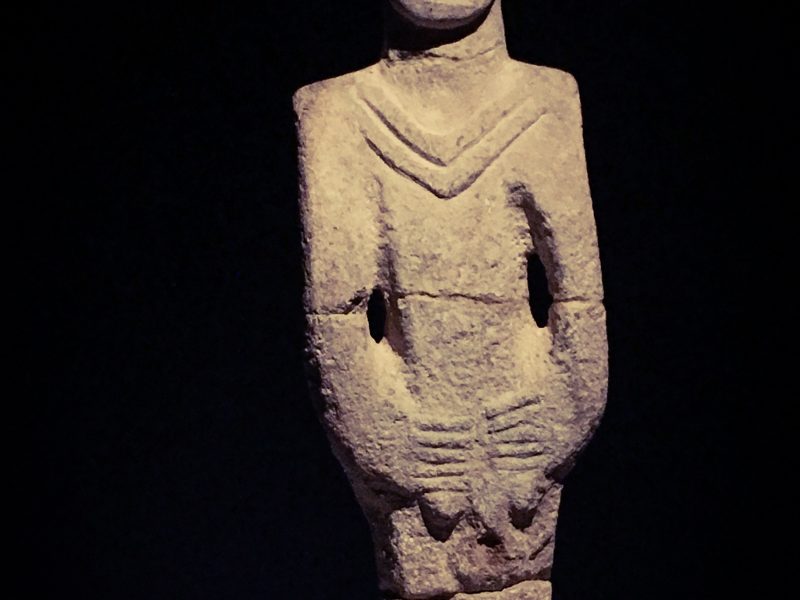
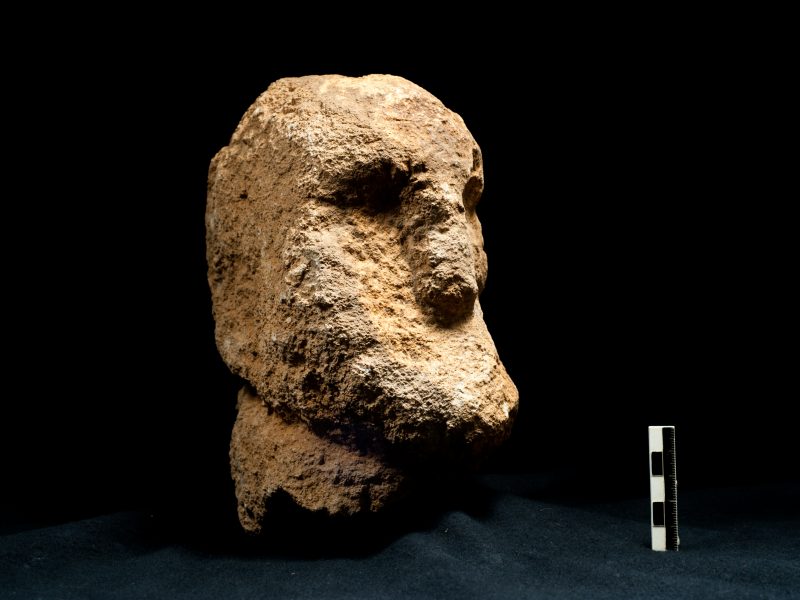
Such circular hollows are found on Göbekli’s pillars too, don’t they?
Some of the pillars do indeed occasionally have similar hollows, although in different positions. Not sure if a related function could be assumed. Something we still would need to look further into.
Thanks so much for your work sharing! At first glance, this appears to be a depiction of pregnancy. This may be obvious to anyone who has experienced pregnancy. Yet you write “In this case the Kilisik example would represent the first female depiction to be associated with the T-shaped sculptures…. a rather vague and ambivalent possibility asking for further research.”
Why do you begin with the assumption that all other T-shaped sculptures are male? Why is a female depiction a “vague” possibility? What happens if you revise your assumptions? Please go on with the further research!
Thanks for your kind words and comment. The interpretation of the T-shaped pillars, and in particular the central pillars of Building D depicted here as well, as male individuals comes from the apparent lack of any clearly identifiable female sexual characteristics – and the depiction of belts and loincloths. Among the clay figurines from Nevali Cori both, men and women are depicted – yet only the men are shown wearing belts. This, together with a generally rather strong emphasis of masculinity among the animal and human images at the Göbekli Tepe (in reliefs – whenever the sex is indicated it is a male specimen, but also sculptures – and here even dominantly ithyphallic depictions), has led to the interpretation as noted.
1. A figure without breasts is not necessarily male. My own breasts were insignificant until I became pregnant and they grew three times larger. A female active in roles other than parenting has no need for breasts.
2. There is no logic in assuming belt and loincloth are worn just by males.
3. An erection between the legs is not necessarily male. Healthy female clitoris may be aroused and erect and visible from the outside. This is true of human and other animals.
4. There are more similarities than differences between males and females.
Again, many thanks a lot for your comment. Regarding your input:
1. While certainly true, it still leaves one pondering while they go through the effort clearly indicating a male sex by depicting penises (phalloi even), but leaving no equally clear hint at female individuals (if they wanted to).
2. The logic lies in analogical reasoning here: If the figurines are clearly distinguished male and female individuals, but only the males are wearing belts, it seems likely to assume these belts are characteristic attributes of male individuals.
3. True. But in the cases discussed, the phallus is pretty much emphasised.
4. Anatomically for sure, both are humans after all. But if specific sexual characteristics are emphasised and even exaggerated, this might seem to mean something, doesn’t it?
Hi there,
Jens, your notion on masculinity of the pilar beings seems to make immediate sense and I’ve read it before in other places (loin cloths etc.). Yet, I think Alice Starr Dworkin makes a very good point! Why should sculptures occasionally adorned with ithyphallic beings be male? The central part of the “composite sculpture” depicted above is sometimes interpreted as woman giving birth. Since it is incomplete but must have been somehow associated with the T-shaped beings, this would make it another associated female being.
As I said in my earlier comment to Alice, the emphasis and exaggeration of certain specific sexual characteristics seem to imply an intention. That does, of course, not mean these ‘composite sculptures’ have to exceptionally be interpreted in that way. It’s in particular their composite character which opens up a much wider possibility in interpretation – thus the possible female link as suggested. Not excluding it at this moment, not at all. But as I said in the article, there’s much more research necessary to really prove this point.
I haven’t read the articles on this site extensively, so apologies if this is already covered elsewhere, but the human form seems to be generally abstract (the pillars) and the animals seem to be carved to represent their actual form. If this observation is correct, is there considered to be some significance to this distinction?
Is it more common for humans to be depicted in abstract forms than animals at other sites and/or other periods?
Thank you.
The noteworthy abstraction is indeed a very specific characteristic of the T-shaped pillars known not only from Göbekli Tepe, but a number of other sites in the region as well (cf. https://www.dainst.blog/the-tepe-telegrams/2016/05/08/the-current-distribution-of-sites-with-t-shaped-pillars).
Since there are also known a number of life-sized and rather naturalistic human sculptures (cf. e.g. https://www.dainst.blog/the-tepe-telegrams/2016/04/24/10th-icaane-vienna and https://www.dainst.blog/the-tepe-telegrams/2016/05/05/losing-your-head-at-gobekli-tepe and https://www.dainst.blog/the-tepe-telegrams/2016/10/14/the-urfa-man), the T-pillars’ abstraction must have been an intentional decision, either following technical aspects (production, function) or symbolic meaning (a clear contrast to the life-sized sculptures with human features, faces etc.) – or both.
Thank you, Jens, for your answer and taking the time to include the links.
It is so tempting to speculate on the relative contributions of production, function and symbolic meaning but I shall resist! I shall just hope that as the evidence is evaluated and new finds are discovered you all get closer to the answers to these tantalising questions.
Instead, at the risk of imposing on your time again, I have a follow-up question.
From what I have read so far there seems to be human, animal, abstract patterns and hybrid (human/animal) sculptures. I think I also read that there were some features that could potentially be the sun and/or moon.
Are there any sculptures of flora or geological features (mountains/rivers)?
Do you have some similar links that discuss this in relation to other archaeological sites and why these subjects may not be portrayed, if they are not?
Thank you again.
Clearly identifiable depictions of plants and geographical features are rare. At least from Göbekli Tepe none comes to mind immediately (one might consider interpreting one or two motives, the ‘centipedes’ for instance, in this respect, but that’s not more convincing than the original interpretation as centipedes imho.
One prominent example of a possible depiction of landscape characteristics and geography may come from (slightly later) Catalhöyük where a mural may (or may not) depict a volcanoe [external link]: https://www.biblicalarchaeology.org/daily/ancient-cultures/ancient-near-eastern-world/catalhoyuk-mural-the-earliest-representation-of-a-volcanic-eruption – Could be a leopard’s skin as well, though. Or something completely different.
First of all, thanks for your wonderful research and the exemplary effort you put into documenting it – in text and pictures – for a broader, non-specialist audience. I have enjoyed many hours browsing your website, being inspired both by the esthetical dimensions of your findings, by the vast perspectives they open up onto our deep past, and (it must be admitted) by the limitless space for speculation they offer. So here, for what it is worth, is one bit of speculation that occurs to me:
Regarding the above discussion of gender, it strikes me – as a social anthropologist – that the possibility seems not to have been considered that some of the figures in question might be engaged in homosexual intercourse.There exists a sizable literature on ritual homosexuality in connection with male initiation in a number of Melanesian tribes (see for example Gilbert Herdt (ed.) “Ritualized Homosexuality in Melanesia”). Since I am not at all a Melanesianist, I must be cautious in how I express myself, but it is apparently considered essential in several of these groups that grown men inseminate young initiates (e.g. by fellatio, cf. the Kilisik sculpture?), or else their masculinity will not grow and mature in them and they will remain children (or perhaps become a kind of stunted women?).
Obviously, it’s a long way from 20th century AD Melanesia to 10th milennium BC Anatolia, but since (a) sexuality (in various forms) is a human universal, which (b) cross-culturally is very often tied to ideas of fertility and authority, it would seem at least possible – (c) in a society undergoing fundamental change (from hunting to agriculture), in which (d) male authority positions might as a result be perceived as under threat – that ritual homosexuality as a component of male initiation could play a role in mitigating that threat (male initiation being, if I have understood correctly, one (of several) possible functions that you are considering for the Göbekli Tepe site). If this were the case, it might conceivably also contribute to an understanding of why the imposing structures were (suddenly?) abandoned and backfilled when the transition to agriculture was seen to be inevitable and new gender roles had been successfully adopted.
Best wishes, pardon my convoluted syntax, and keep up the good work!
Dear Mr.Notroff,
Thank you for this interesting article and the way you work in connecting the dots between the different finds that start uncovering a scarcely known part of the history of Anatolia. I always wondered why the figure underneath the belt of the T-shape pillars in enclosure D was interpreted as a “loin cloth” and not as the lower part of a fox skin. To me the depiction is clear enough that the tail of the fox is pointing towards the ground with its two rear legs. This is reinforced by the fox figures on the side of the pillar. There may still be in this a connotation of penis but I believe it joins the concept of the Fox with the deity. I will be glad to hear your point of view on this on my e- mail below. Best regards
Sehr guten artickle danke schön..
I write in this topic because is teh most recent topic about the shapes of pillars.
I found this figurine in a search about a different thing, and it remains me the pillar of gobekli tepe. How intriguing for me when I noticed that it was found at the south of France, at Brassempouy. (Picture at the link)
https://donsmaps.com/images33/img_5195venuscape.jpg
Could this called “Venus” be related to Gobekli Tepe?